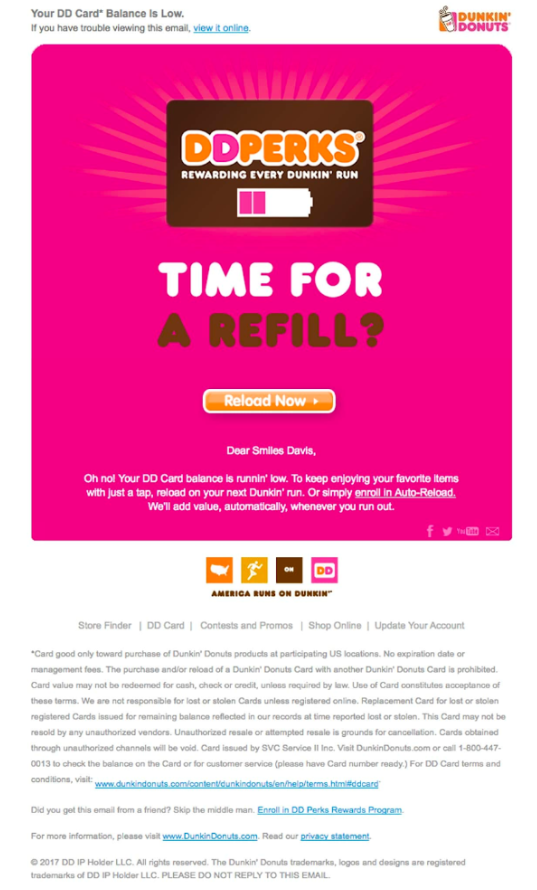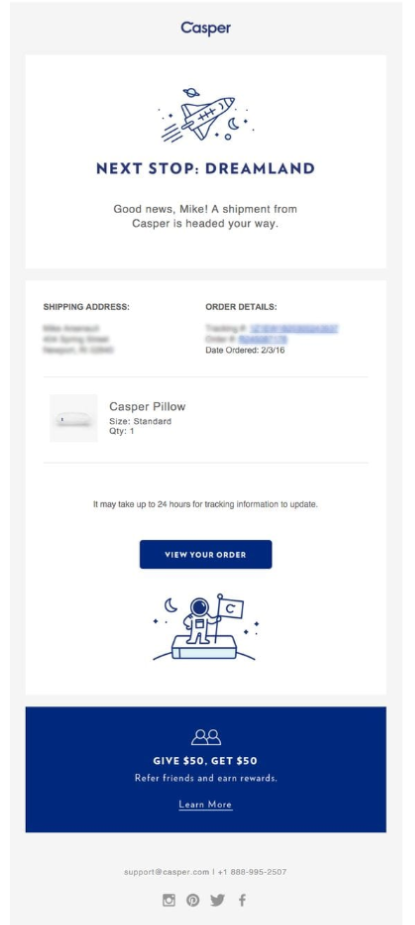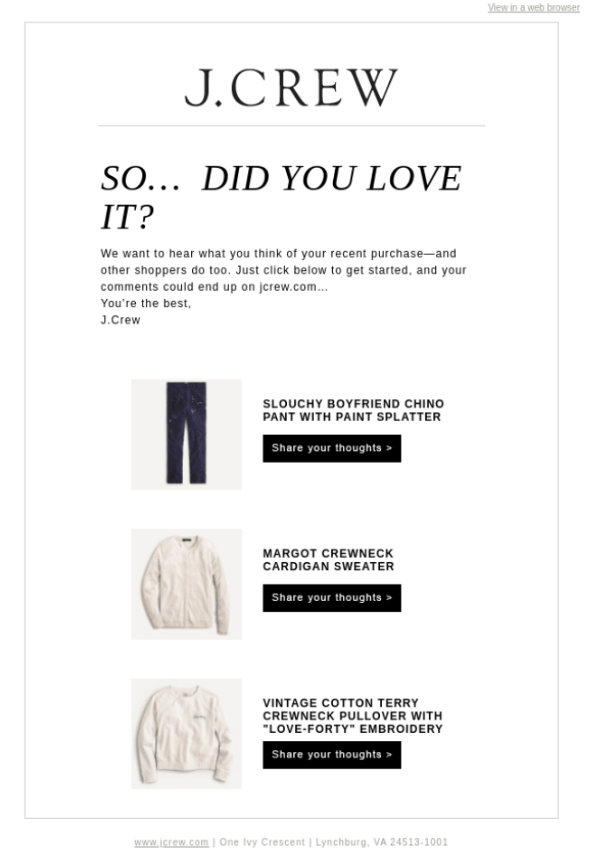An Introduction to Transactional Emails and How to Send Them Right
the 05 of December of 2022
the 05/12/2022
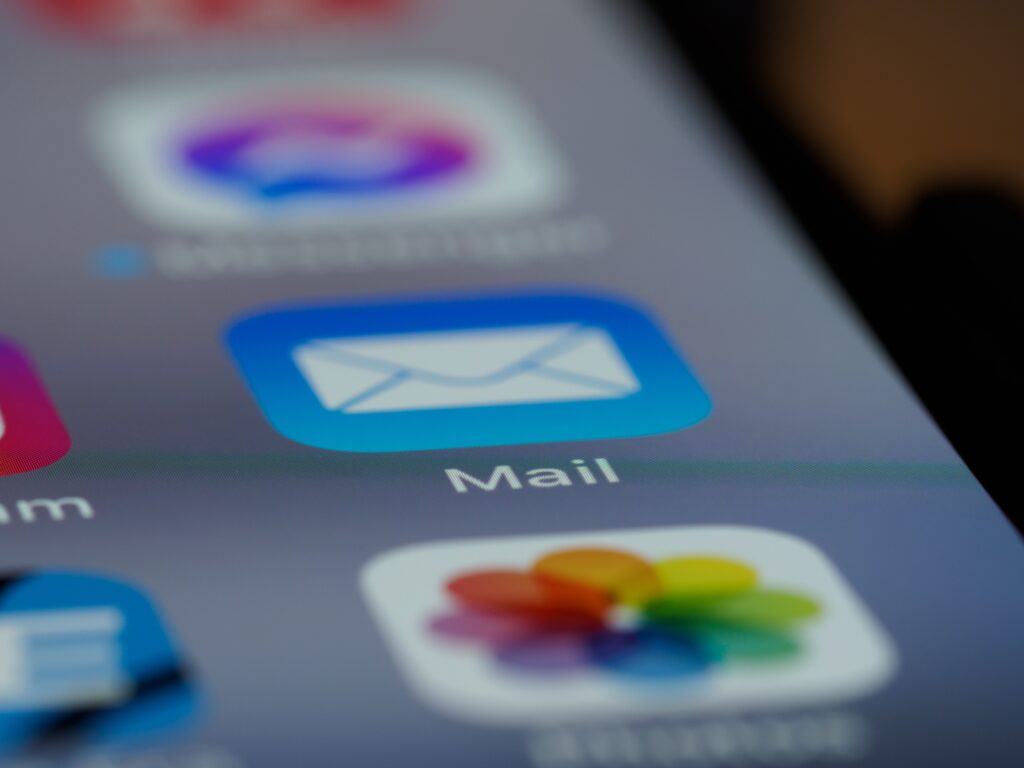
Every time you finish an Uber trip, buy something from Amazon or change your password in Airbnb, you get an email. It may be a receipt, confirmation message, or new sign-up alert. Simply put, your — user — actions trigger a system, and in a second, there is +1 unread message in the inbox. That is a transactional email. To dig into transactional emails, today we will cover transactional messages — what they are, what are the best practices for building them, how to choose between SMTP and email API for sending transactional emails, and how to find the proper sending provider.
TABLE OF CONTENTS
What is a Transactional Email
Transactional (or triggered) emails are messages users automatically get when interacting with a website, app, software, or any other product. The “transaction” stands not only for buying or selling something. For example, a new password, information update, or any account notification — everything can trigger a transactional email.
There is a slight difference between transactional and triggered emails. Unlike triggered emails, all transactional messages are for user-generated actions. Triggered messages like monthly reports and birthday notifications have pre-specified triggers. Users don’t need to activate them — a system does everything without external assistance.
The absence of transactional messages may affect business. Because without a password reset or email verification, the user cannot move further and use website functionality. Some messages may not seem crucial for users — like purchase confirmation — but people expect to get such emails to be sure the transaction was successful. If users don’t receive them, they may think the operation failed.
Characteristics of a Transactional Email
Several things define transactional emails:
- Event-driven. The system sends the relevant email as soon as the user takes action.
- One-to-one basis. Transactional emails are always sent to individuals and have unique and confidential information.
- Opt-in isn’t required. According to Legitimate Interest in privacy law, if users expect to get this kind of email, there is no need to opt-in.
- No unsubscribe link. Recipients trigger transactional messages, so the email shouldn’t have an unsubscribe button.
- Outside of CAN-SPAM and GDPR. Even though transactional emails may have minimal commercial messaging, they are still outside the scope of data protection and privacy legislation.
- Metrics. Success metrics of transactional emails are measured by the speed of delivery and open rates.
The Difference Between Transactional and Marketing Emails
Marketing emails are messages devoted to marketing campaigns, newsletters, product updates, or other news. Marketing teams are building such emails to sell something to their customers. These messages are sent in bulk to multiple users and are never triggered by users.
Hence, Marketing emails have specific characteristics:
- Subscription only. Recipients must subscribe to the email list and opt-in to receive such content. In other way, companies cannot send their commercial information to users.
- One-to-many basic. A pool of recipients gets marketing emails at the same time. Marketing emails are sent to some category of recipients, depending on their interests, location, age, gender, or any other marker.
- Compliant with CAN-SPAM and GDPR. All marketing emails should be built in compliance with data protection and privacy legislation like GDPR.
- Opt-in is required. Businesses should receive consent to send out such communication to users.
- An Unsubscribe link is a must. To comply with all the legal standards and create a user-friendly experience, companies must include an unsubscribe button at the end of their marketing emails.
- Whitelisting IP required. To avoid being blocked on certain networks, the sending IPs need to be added to the company’s allowlist.
To differentiate marketing and transactional emails, we should cover the types of marketing messages existing out there.
- Promotions and sales. Such emails motivate users to follow the link and buy something from the company.
- Newsletters. These messages allow companies to communicate with their users and share some insights.
- Abandoned cart. If customers leave their cart halfway through the purchase process, they may get a finish-your-order message. It may only seem to be an email triggered by users’ actions. In reality, the users’ email must be in the email marketing list to get such a notification, so it is a marketing message.
To sum up, the difference between transactional and marketing emails cannot be mixed up:
| Transactional email | Marketing email |
|
|
|
|
|
|
|
|
|
|
|
|
|
|
|
|
|
|
|
|
Types of Transactional Emails
Types of transactional messages depend on the company’s business. For example, food delivery companies may use confirmational, verification, and delivery details emails. At the same time, dating apps may send notifications about user activity, new messages, matches, etc. Nevertheless, the most common transactional emails are relevant for every business:
- Welcome emails. Transactional welcome messages can contain details about the new account, links to help guides, support channels, or CTAs to explore the service.
- Account management. Users get such an email whenever they create a new profile, deactivate, or delete it.
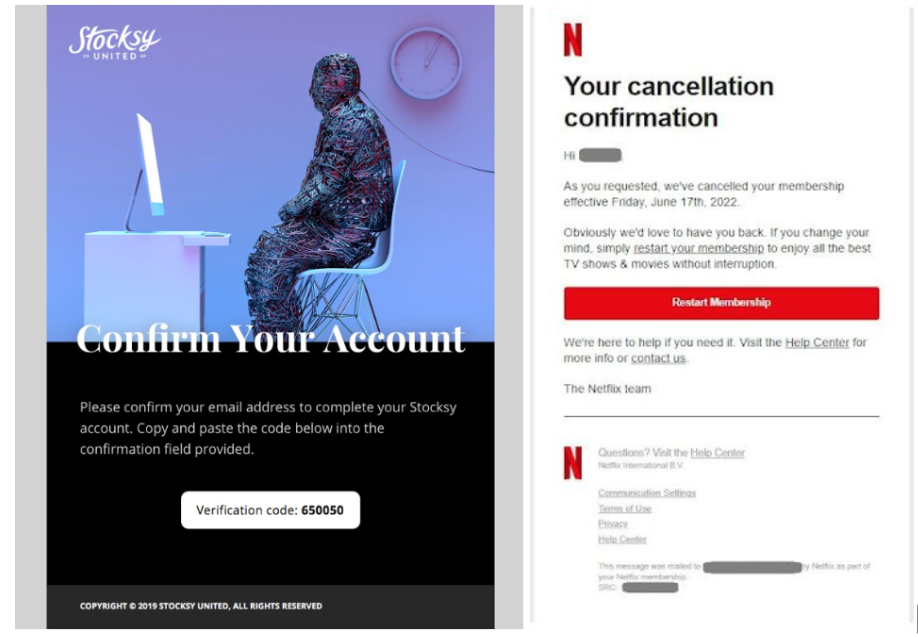
- Verification. This kind of email is the best practice of the double opt-in method. For example, when a message is sent to new users to verify their addresses, it may also ask to confirm that the user is willing to sign up for the email list. These emails usually have confirmation, unsubscribe links, and CTAs to learn more about the company and its services or products.
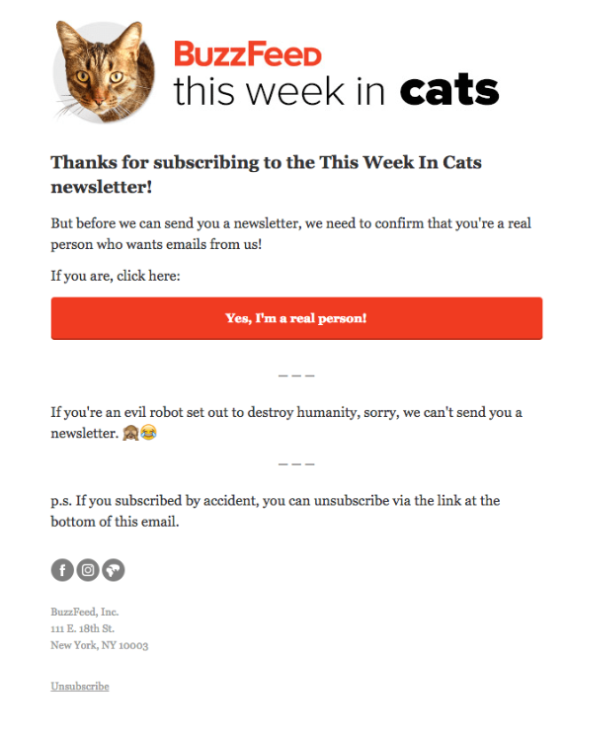
- Password details. At least once in a lifetime, we hit that “forgot my password.” It triggers an email with a unique link to the password reset page that will expire sometime soon.
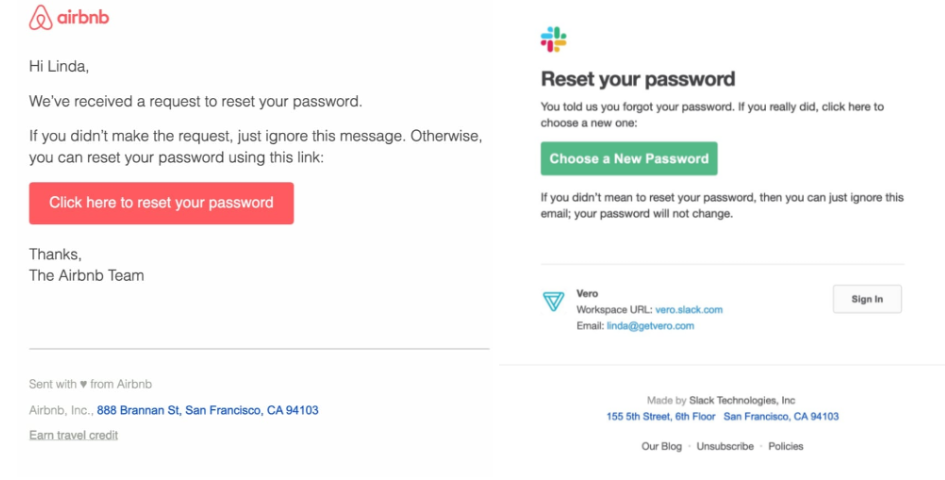
- Notifications. All those security alerts about new sign-up, policy changes, monthly reports, or account reminders are notification emails that make the user flow seamless and as comfortable as possible. Businesses also send shipping notifications, delivery updates, and information about the trial period or expiration of subscriptions to keep users in the loop.


- Feedback request. Users may get such an email to leave feedback on some company-provided service.
 – Legal update. Transactional messages are also a great way to inform users about changes in policies, legal documents, or regulations.
– Legal update. Transactional messages are also a great way to inform users about changes in policies, legal documents, or regulations.

- Receipt or details on purchase. Such emails serve one purpose — to ensure a positive customer experience. Along with the order confirmation number, cancelation & return policy, and FAQs, there may be links to similar products, top sales, or CTA to leave a review.
Marketers may use every type of email to get honest feedback, lead the recipient to specific pages of the website, recommend services and products and notify of any upcoming events, sales, or updates. Nevertheless, it is essential to remember that transactional emails should have as little commercial content as possible due to law and compliance with CAN-SPAM and GDPR.
The Best Practices for Transactional Emails
Marketing emails may land in the spam folder — users may just skim through the text or leave it unread. At the same time, transactional emails are those users wait for, open and read till the end. That’s why companies should ensure their transactional messages are understandable, recognizable, and follow the best practices:
- Personalization. Transactional messages are made from templates. But there is still that place for auto-fill information like the user`s name or nickname that makes the message more personalized, unique, and pleasant.
- Mobile Responsive. Small fact: 43% of users open emails on phones. When the business hasn’t considered that fact, users’ experience may be destroyed.
- Branding. Transactional messages shouldn’t be boring. Businesses may add logos, links to social networks, or use something except for Times New Roman together black-n-white combination. It doesn’t take long to refresh the way small messages look, but it will certainly enhance user experience.
- Simplicity. All transactional emails have a specific goal. There is no need to overfill the page with ten CTAs, and hope that users will visit every page company added there.
- The subject line and pre-header. Before opening an email, users should understand its context just by looking at the subject line. The complex and vague description may leave the message unread or — even worse — put in a spam folder.
- Copy. Even the “Click here to get a new password” message can become more user-friendly and less worn out. Through all communications, transactional emails should stick to the Tone of Voice of the company. To improve this, make your user recognize you from the first lines of the message.
- Avoid no reply. Users like to communicate with real people — even if they have never met them. If you don’t like the idea of having something like “Kate from Google” as s sender, try “Google Support” or something similar. But businesses should forget about the no-reply option if they don’t want to receive no-read as an aftermath.
- Cross-selling and upselling. That is something that can skyrocket sales. Try to recommend similar items in every purchase confirmation letter, and the results will be excellent — approved by Amazon.
- Preferences management. Users should be able to manage their email preferences and get the most relevant notifications. Place the link to a page where users can change settings and let people choose which messages they get.
- Extra value. Additional content like promo codes, tips, recommendations, or a slight reminder about Black Friday deals can improve user-company interaction. Take a look at Uber, and the message users get after a ride. It has tons of information: ride summary, ability to leave reviews or tips, CTA to get the UberEATs app, and sign up for credit card. It is the ideal example of how a business can promote its services via transactional emails.
Sending Transactional Emails
There are a lot of articles on how to create transactional emails, settings, and best management practices. We will cover the most frequently asked questions.
Email Sending Provider Role
Many transactional email services offer two main ways of sending emails — SMTP and API. API is a faster and more reliable way to send emails. It provides a more flexible way of integrating with your app or service. Nevertheless, APIs require more complex coding solutions and aren’t as versatile as SMTPs. So, the first step in choosing a provider is deciding which method to use.
When a company selects a provider, they initially use providers’ shared IPs. It is advised only if the company doesn’t have enormous volumes of messages. A provider is in charge of IP warm-up and its reputation. Imagine: you pick up a provider and start sending hundreds of messages. The recipients’ emails may consider such activity suspicious and mark messages as spam. Providers must control the number of messages sent, manage to throttle, and gradually increase the volume. A professional remote server monitoring service is consigned to detect and eliminate the issues with your business mail, marketing lists, SMTP connection, or IP address error.
Domain Verification & Authentication
To allow email providers to send messages on the company’s behalf, the company has to prove that it is the only owner of its domain — that is domain verification. Without that, spammers can use the domain to spread any information.
After verification, the company should also get domain authentication. Thus, this step is important as it ensures good email deliverability. There are several factors that influence deliverability besides the infrastructure itself – content, sending volume, and bounce rate. A few additional types of records can be added to the DNS settings to perform domain authentication, and you can use tools like email verifiers to make sure you’re sending the email to the right person. Following a consistent schedule, avoiding spam traps, and building the right reputation are equally important for improving your email deliverability.
Verifying a domain for transactional emails and getting authentication are not complicated processes and take little time to complete.
Transactional Emails Testing
Before saving a template or sending a transactional email to users, you need to check if the message works appropriately. What can possibly go wrong? Buttons and links don’t work, users cannot download invoices, or the mobile version of the email is not displayed correctly — many things may not go as planned.
To test email, companies use fake SMTP servers like Mailtrap. It ensures that you choose the only person that sees the test email, and that it doesn’t land in the mailboxes of real users. Such servers also may check if the email can fall into the spam folder — another essential feature.
To Sum Up
Transactional emails play an important role in the functioning of the entire service because they help the user to create a profile, choose a payment method, and confirm or cancel the purchase. So, the user experience will be extremely poor without these messages.
When the company analyzes the entire customer journey, creates the relevant transactional messages, and makes them according to the best practices, it may see how automatically triggered emails can boost the user-company relationship.
